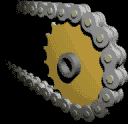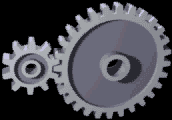Chain vs. Belt Vs. Gear Drives
There's a few ways to transmit mechanical power from one place to another, but arguably the three most common methods are using a chain, a belt, or gears. In my research for a drive system for my electric mountainboard, I found quite a bit of information on what's good for what. I want to summarize my findings here.
Drives 101
Chain Drive
Chain drives transmit power using the tensile force of a chain. There's many different kinds of chains, all designed for certain tasks. At its core, a chain is made up of many links with rollers, which interface with the teeth in a sprocket. When a sprocket turns, the teeth pulls one end of the chain, which turns the other sprocket.
Chain sizes are generally standardized based on the dimensions of the chain. This dictates what sprockets can be used. They can also be stacked together to form wider chains, which can handle greater loads. Some sizes also have heavy duty versions, denoted with an H. They fit on the same sprockets as the normal ones since they have the same interior dimensions and length, but have slightly thicker links so they can hold more weight.
Belt Drive
A belt drive is very similar to a chain drive, only the power is transmitted using a flexible belt. I will cover main styles of belts - a tooth/timing belt, which functions similarly to a chain, and the V-belt, which is completely smooth and instead relies on friction. There are other styles, such as flat belts and spring belts, but they will not be covered here.
Belt sizes are determined by tooth pitch and width, or simply width if it is a V-belt. The pulley needs to match the pitch of the belt, otherwise slippage could occur. A narrower belt can fit on a wider pulley, but it will often be suboptimal.
Gear Drive
Finally, a gear drive operates using meshed teeth. As one gear spins one direction, the locking teeth forces the other gear to spin the other direction. This differs from a belt or chain system, because in those, the rotation direction is the same as the power source. To do that on a gear drive, you would need a third gear in the middle to switch the direction back.
There's many different types of gears, from the simple straight cut spur gear to helical or herringbone gears. Spur gears are the simplest to manufacture, but also the loudest. Helical gears twist the teeth somewhat such that more are in contact at any given time, but are more difficult to make and impart an axial load on the gear. Gears need to be matched based on pitch, or how many teeth there are per inch, and pressure angle.
Reliability
In terms of reliability, both gear and chain drives have lower limits in fatigue strength. In general, gear drives tend to be the most reliable. However, chain sprockets tend to get less wear compared to gears because the load gets distributed over many teeth, unlike gears which usually have the load all under a few teeth.
The same goes for inspection. Gears generally get louder as it wears down, which can serve as a warning for the end of its service life. For chains, you can measure the elongation of the links, or look for vibrations. However, with belts, it is difficult to check the belt condition without careful inspection, which would involve shutting down whatever it was powering.
TLDR: Gear > Chain > Belt
Maintenance
Chain drives have the most maintenance required, as the chain consists of a huge number of moving parts. The chain has to be periodically cleaned and lubricated to ensure maximum efficiency, and it loses efficiency much more quickly when it gets dirty compared to a belt or gear drive. Too wet of a grease attracts dirt and debris, so chains often use wax based "dry" lubricant.
Gears also require regular lubrication, as there is constant metal on metal contact. However, gears tend to be used in sealed systems, which limit dirt from getting in, which generally affords them much longer service spans compared to chain. The gears themselves however should last an extremely long time given regular maintenance.
Belts are slightly different compared to the other two. While belts do not require the periodic lubrication chains and gears do, they tend to stretch over time faster than a chain, which requires constant retensioning to maintain efficiency and prevent skipping. Belts also have a shorter lifespan, which means they would need to be replaced more often compared to a chain.
TLDR: Gear > Belt > Chain
Utility
Belts have some traits which are good for some use cases. They act as a fuse for the mechanism, breaking when a jam or overload occurs. This protects the other components from breaking. The belts also dampen noise and vibration, and smooth out any shocks, extending machine life. V belts also allow some slip, which may be useful in some use cases. However, belts tend to have a very fixed operating temperature, and put a large amount of strain on the shafts in order to keep it tensioned. They are ideal for long transmission distances and high speed, low torque tasks.
Chains are quite flexible in what they can do. They can handle massive gear ratios and cover great distances, although usually not as long as belts can go. In addition, they are easy to size and connect together. Power can be driven with both sides of the chain, unlike most tooth belts, which only have teeth on one side. They can operate in adverse conditions, and don't apply as much load on the shafts compared to a belt. They are best suited for long term continuous running, and power transmission with limited torque fluctuation, or in adverse conditions.
Gears are the most efficient way to transfer power. There's absolutely no slip, and the gears are much stronger than a belt or a chain. Gears aren't confined on the same plane, so you can transfer power at an angle, which is impossible with a chain. They also allow for even larger ratios than chain sprockets. Gear drives do have quite a few limitations though. The biggest one is that they don't handle power transmission over long distances well. That would either require many gears, or very large gears, and both methods would be much heavier than an equivalent belt or chain system. Their efficiency also means that any shocks would be transmitted directly to the machinery, which can cause damage or wear. Gears are good for mechanisms that need reversing or run intermittently with a lot of torque.
TLDR: Depends on your use case
Cost
Unsurprisingly, gears are the most expensive. They require more precision than the other methods, and they are much more difficult to manufacture compared to a sprocket or belt pulley. For the same transmission conditions, toothed belts and pulleys actually cost more than equivalent chains and sprockets. V belts are the simplest to manufacture and the cheapest, but the slip can make them unsuitable for some tasks. The shorter service life of belts also means you'll need to spend more over time replacing them compared to a chain or gear.
TLDR: Chain > Belt > Gear
Conclusion
This gives a very high level look at the differences between the three common drive systems. Ultimately, all three systems have their benefits and drawbacks, and which one to use depends on the use case. In the case of my project, all three of them have been used, and the pluses and minuses are very visible. Belts for example snap pretty often, but because of the price, they're the most common system around. Chain is rather rare due to the large sprockets needed, and is mostly reserved for mountainboards, which operate in adverse conditions. Lastly, gear drives are very expensive, but quite good for use in skateboards. The ratios tend to be low however, which forces design constraints in motors to get a balance between speed and torque.
Sources
https://www.ustsubaki.com/pdf/the-complete-guide.pdf
https://www.powertransmission.com/blog/a-look-at-belt-chain-and-gear-drive-technology/
http://www.staff.city.ac.uk/~ra600/ME2105/Analysis/ME2104-A-3.pdf






Comments
Post a Comment